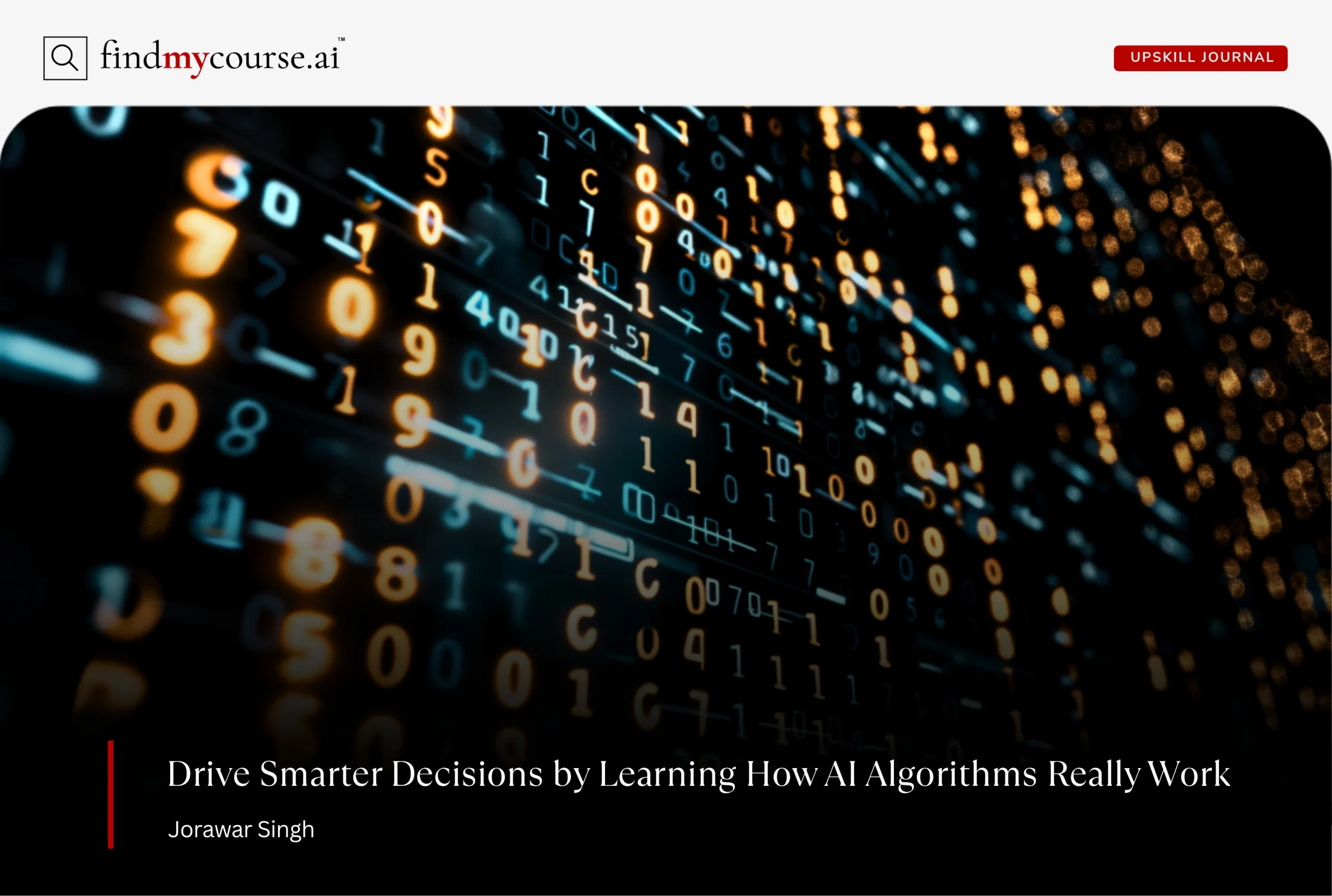Imagine a world where machines can learn from experience, make decisions, and even predict the future—this is the reality AI is creating today. At the heart of this technological revolution are AI algorithms, the intelligent engines that enable machines to analyze data, recognize patterns, and act autonomously. For professionals looking to upskill, understanding AI algorithms is no longer optional—it’s also a strategic advantage. Whether you’re exploring career opportunities in technology or seeking to strengthen your digital expertise, mastering how AI algorithms work can unlock new possibilities, enhance decision-making, and position you at the forefront of innovation.
What Are AI Algorithms?
AI algorithms are essentially sets of mathematical instructions that enable machines to analyze data, recognize patterns, and perform tasks autonomously. Unlike traditional programming, where specific rules are manually coded, AI algorithms learn from examples. By processing vast amounts of data, these algorithms also adapt and improve over time, making predictions or decisions without explicit human intervention.
In simple terms, AI algorithms act like a student learning from experience: the more examples they encounter, the better they become at understanding complex patterns. This capacity to learn is what makes AI so versatile, powering applications from virtual assistants to autonomous vehicles.
Types of AI Algorithms
AI algorithms are categorized by learning approach—supervised, unsupervised, and reinforcement—each suited to specific problems. Moreover, this classification helps identify how algorithms learn from labeled data, discover hidden patterns, or optimize decisions through feedback, guiding effective real-world applications:
| Type of Learning | Data Requirement | How It Works | Key Features | Common Applications |
| Supervised Learning | Labeled data (inputs paired with correct outputs) | The algorithm learns the relationship between input and output by training on examples. It predicts outcomes for new, unseen data based on learned patterns. | High accuracy with sufficient data, error correction through feedback, relatively easy to interpret | Image recognition, spam filtering, fraud detection, medical diagnosis, predictive analytics |
| Unsupervised Learning | Unlabeled data | The algorithm identifies hidden patterns, structures, or clusters in data without predefined labels. It groups similar data points and detects anomalies. | Reveals hidden insights, good for exploratory analysis, handles large datasets efficiently | Customer segmentation, anomaly detection, trend analysis, recommendation systems, market basket analysis |
| Reinforcement Learning | Environment with feedback (rewards/penalties) | An agent interacts with its environment, takes actions, and learns to maximize cumulative rewards. Decisions are refined through trial and error over time. | Learns optimal strategies, adapts dynamically, effective for sequential decision-making | Robotics, autonomous vehicles, gaming AI, resource optimization, supply chain management |
How AI Algorithms Work
AI algorithms follow a structured process that enables them to learn from data and make intelligent decisions. While the underlying mathematics can be complex, the workflow can be understood in logical, intuitive steps. Each stage builds on the previous one, ensuring that the final model is accurate, reliable, and practical:
1. Data Collection
Data collection is the foundation of AI algorithms. High-quality, relevant data allows the model to identify patterns and relationships effectively. Moreover, incomplete or inaccurate data can lead to poor predictions. Gathering diverse datasets from reliable sources, such as Kaggle, ensures the algorithm learns comprehensively, making outcomes accurate and dependable.
2. Data Preprocessing
Data preprocessing transforms raw, messy information into a clean, structured format suitable for analysis. This step involves handling missing values, removing inconsistencies, normalizing, and encoding data. By preparing the dataset properly with tools like Pandas in Python, algorithms receive meaningful inputs, which significantly improves learning efficiency and model performance while reducing errors and biases.
3. Model Training
During model training, the AI algorithm examines the prepared data and adjusts its internal parameters to detect patterns. Similar to repeated practice, the model iteratively improves its understanding, minimizing errors. Frameworks such as TensorFlow or PyTorch are often used to train models effectively and optimize predictive capabilities for new, unseen data.
4. Model Evaluation
After training, the algorithm is tested on new, unseen data to measure performance. Metrics such as accuracy, precision, recall, and F1-score evaluate how well the model generalizes. Using libraries like Scikit-learn, developers can accurately assess performance, identify areas for improvement, and prevent overfitting to ensure the model works reliably in real-world applications.
5. Inference and Decision-Making
Inference is the stage where the trained algorithm applies its learning to make predictions or recommendations. It transforms raw input into actionable outcomes, such as suggesting products, diagnosing conditions, or predicting trends. Platforms like AWS SageMaker simplify deploying models, allowing AI to deliver practical, real-world insights efficiently.
Real-World Applications of AI Algorithms
AI algorithms are no longer theoretical—they are present in countless real-world applications, transforming industries and improving daily life.
| Industry | How AI Algorithms Are Used | Benefits / Impact |
| Healthcare | Diagnose diseases using medical images, lab results, and patient histories; predict outcomes; personalize treatments; monitor health via wearable devices. | Enhances accuracy, reduces human error, improves patient care, and supports preventive health management. |
| Finance | Detect fraudulent transactions, optimize investment strategies, analyze large datasets, automate credit scoring and portfolio management. | Faster, reliable, and cost-effective decision-making; improved risk assessment; streamlined operations. |
| Retail | Power recommendation engines, manage inventory, run targeted marketing campaigns; analyze consumer behavior and purchase trends. | Personalized customer experiences, optimized stock levels, higher engagement, increased revenue and satisfaction. |
| Transportation | Enable autonomous vehicles for navigation, obstacle detection, traffic prediction, and route optimization. | Improves road safety, reduces travel time, enhances logistics efficiency for personal and commercial transport. |
| Entertainment | Analyze viewer preferences and behavior; personalize content recommendations, curate playlists, optimize release strategies. | Creates engaging, tailored experiences, increases user satisfaction, and boosts platform retention. |
These examples also demonstrate that AI algorithms are not confined to labs—they actively shape industries, enhance productivity, and influence consumer experiences worldwide.
Common Challenges in AI Algorithms
AI algorithms offer powerful solutions across industries, but they are not without challenges. Understanding these pitfalls is essential for professionals seeking to implement AI effectively and responsibly. Here are the most common issues:
- Data Quality Issues: Algorithms require accurate, diverse, and well-labeled data. Incomplete, biased, or noisy data can lead to incorrect predictions and reinforce existing biases.
- Overfitting: Models that perform too well on training data may fail to generalize to new data. Careful model selection and parameter tuning are necessary to prevent overfitting.
- Interpretability: Complex AI models, especially deep learning systems, often function as “black boxes.” Lack of transparency can hinder trust and adoption in critical sectors like healthcare and finance.
- High Computational Requirements: Training sophisticated models demands substantial processing power, memory, and time, which may limit access for smaller organizations or individuals.
- Ethical and Regulatory Concerns: AI must be used responsibly. Ensuring fairness, transparency, and compliance with data privacy regulations is crucial to prevent misuse or harm.
By recognizing and addressing these challenges, professionals can leverage AI algorithms more effectively, creating reliable, responsible, and impactful solutions across industries.
Conclusion
While AI algorithms are complex, they are also powerful tools shaping the future of work and technology. By understanding their mechanics, applications, and challenges, professionals can apply them effectively, avoid common pitfalls, and innovate responsibly. Moreover, embracing AI knowledge isn’t just about keeping pace—it’s about leading the way, making smarter decisions, and creating real impact in any industry. And if you’re ready to start or have any questions, our AI assistant is here to guide you every step of the way.


